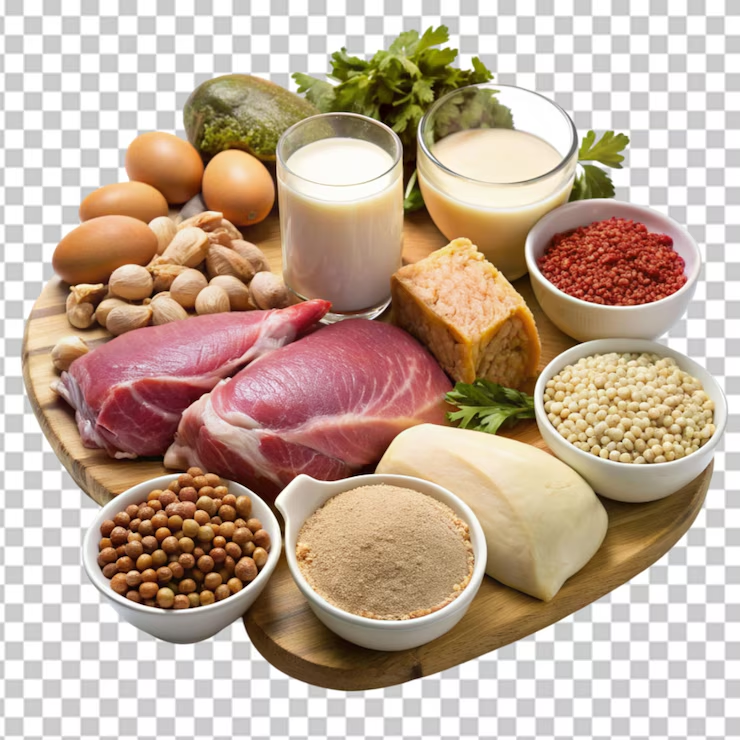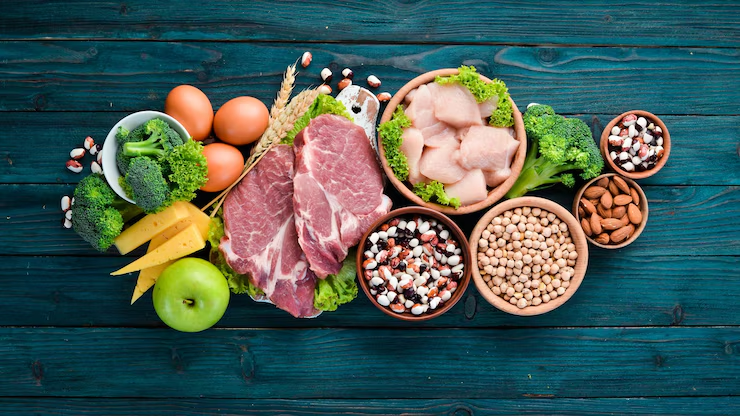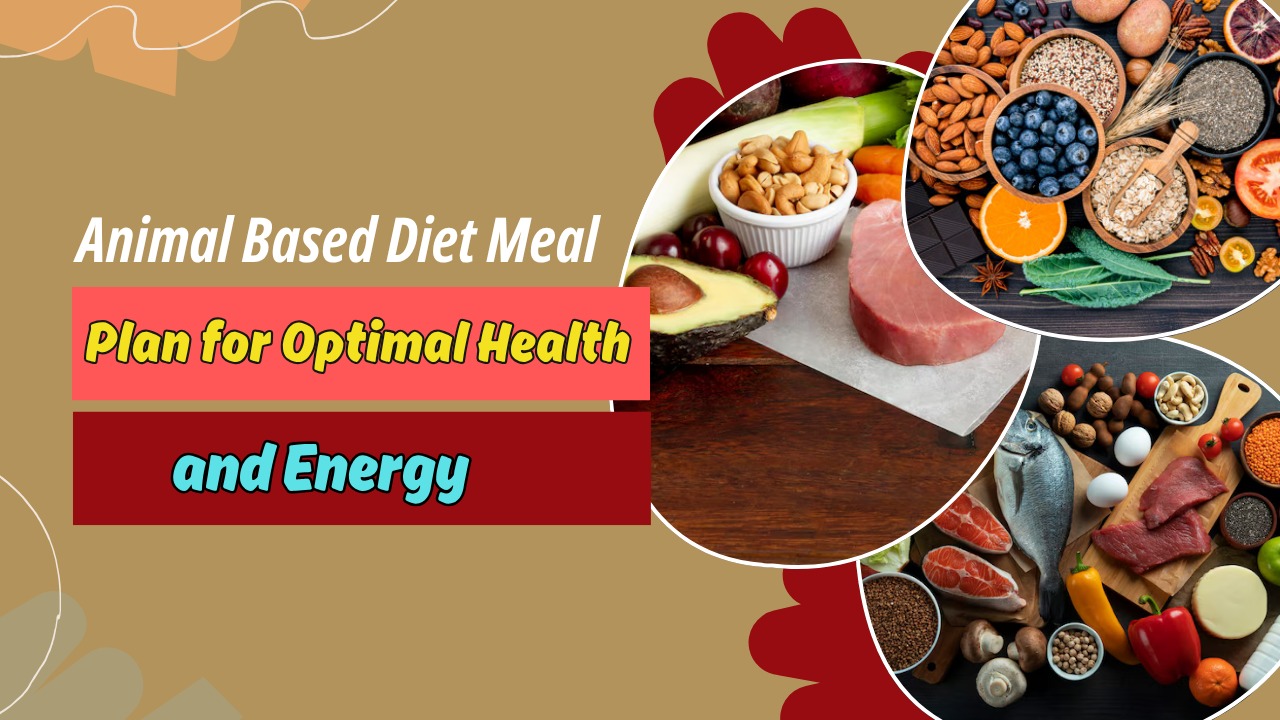Animal-based diet meal plan are gaining traction as more people seek simplified, nutrient-dense ways of eating. This approach emphasizes whole animal-derived foods like meat, eggs, fish, and dairy, while minimizing or excluding plant-based items such as grains, legumes, and even fruits and vegetables.
Proponents believe that an animal-based diet meal plan aligns with our ancestral eating patterns and offers superior nutrition. Animal products are rich in complete proteins, essential fatty acids, and bioavailable vitamins like B12, iron, and zinc—nutrients often harder to absorb from plant sources. Many individuals report benefits such as better digestion, clearer skin, enhanced mental focus, and reduced joint pain.
If you’re considering transitioning to an animal-based diet meal plan, this guide will walk you through the essentials—from what to eat and what to avoid, to sample meals and expert tips for long-term success. It’s a straightforward yet powerful shift toward whole-food-based nourishment and sustainable health.

What Is an Animal-Based Diet ?
Animal-based diet meal plan refers to a nutritional approach that focuses primarily on consuming foods derived from animals. This includes red meat, poultry, fish, eggs, and dairy products while drastically limiting or completely excluding plant-based foods like vegetables, fruits, grains, legumes, and seeds. The goal is to return to a more ancestral, nutrient-rich way of eating.
Supporters of the animal-based diet meal plan argue that animal products offer complete proteins, healthy fats, and highly bioavailable vitamins and minerals such as B12, iron, zinc, and omega-3s. These nutrients are often harder to obtain or absorb from plants, making animal-based foods a more efficient source of fuel for the body and brain.
Though controversial, this way of eating has gained popularity among individuals seeking improved energy, reduced inflammation, and better metabolic health. As with any dietary shift, it’s essential to understand how to structure an effective and sustainable animal-based diet meal plan.
The animal-based diet emphasizes whole foods sourced from animals:
Meat: Beef, pork, lamb, bison, and game meats.
Poultry: Chicken, turkey, duck, and other birds.
Seafood: Fish (salmon, mackerel, sardines) and shellfish.
Eggs: Preferably free-range or pasture-raised.
Dairy: Butter, cheese, cream, yogurt (mostly full-fat, fermented, and from grass-fed animals).
Organ meats: Liver, kidney, heart, brain, and bone marrow.
This diet often excludes or severely limits:
Fruits and vegetables
Grains and legumes
Processed foods, sugars, and plant oils
Some people follow a strict version (sometimes called the carnivore diet) eliminating all plant foods, while others adopt a more moderate animal-based diet that allows small amounts of low-carb plant foods.
Why Choose an Animal-Based Diet ?
Nutrient Density and Bioavailability: Animal foods provide all nine essential amino acids, essential fatty acids, and fat-soluble vitamins (A, D, E, K) in highly bioavailable forms. Organ meats like liver are particularly nutrient-rich, providing vitamin B12, iron, and choline, which are crucial for brain, immune, and metabolic health.
Simplified Eating and Satiety: Many followers find the animal-based diet simpler than complex mixed diets, reducing decision fatigue and often experiencing greater satiety from protein and fat-rich meals, which help regulate hunger hormones.
Potential Health Benefits
Reports from individuals and some early research suggest:
Improved mental focus and mood stabilization
Reduced chronic inflammation and autoimmune symptoms
Weight loss and better metabolic health
Enhanced digestion and reduction of IBS symptoms
Challenges and Common Questions
What about fiber? Although fiber is low or absent, many report improved gut health. Some consume fermented dairy or bone broth to support digestion.
Vitamin C concerns: Present in small amounts in raw organ meats and some seafood, some also supplement or include small plant foods.
Long-term effects: Ongoing research is needed, so monitoring blood markers and symptoms is important.
How to Build an Effective Animal-Based Diet Meal Plan
Prioritize Quality Sources
Animal-based diet meal plan success begins with choosing the highest quality animal products available. Opting for pasture-raised, grass-fed, and wild-caught sources ensures your meals are packed with superior nutrients like omega-3 fatty acids, vitamin D, iron, and CLA (conjugated linoleic acid), all of which support optimal health and performance.
Include Variety of Animal Products
Animal-based diet meal plan success depends on variety, not just quantity. To meet your body’s full nutritional needs, it’s important to incorporate a range of animal-derived foods, each offering unique benefits. Muscle meat, such as beef, chicken, and lamb, provides high-quality protein, iron, and B vitamins essential for energy and strength.

Balance Protein and Fat
Animal-based diet meal plan strategies prioritize fat as the main source of fuel. Unlike carb-focused diets, this approach encourages the consumption of healthy animal fats to support energy levels, mental clarity, and metabolic function. Fatty cuts of meat like ribeye, lamb shoulder, and pork belly are not only delicious but provide essential nutrients and sustained energy.
Meal Timing and Frequency
Animal-based diet meal plan approaches often emphasize simplicity and intuitive eating. One key strategy is listening closely to your body’s hunger cues. Unlike high-carb diets that may lead to frequent hunger and energy crashes, animal-based meals are rich in protein and fat, which promote longer-lasting satiety.
Sample One-Day Animal-Based Meal Plan
Here is your animal based diet meal plan presented in a clean, structured table format:
| Meal | Menu |
|---|---|
| Breakfast | – 3 scrambled pasture-raised eggs cooked in butter – 4 slices of bacon – 1 cup bone broth |
| Lunch | – 8 oz grilled ribeye steak – 2 oz chicken liver pâté – 1 oz aged cheddar cheese |
| Snack (Optional) | – 2 hard-boiled eggs – Few slices of salami |
| Dinner | – 7 oz pan-seared salmon fillet – Roasted pork belly strips – Bone marrow spread on the side |
This animal based diet meal plan includes nutrient-dense animal products that provide high-quality proteins, healthy fats, and essential micronutrients to support energy, satiety, and overall well-being.
Top Tips for Following an Animal-Based Diet Meal Plan
Choose High-Quality Animal Products
When following an animal based diet meal plan, the quality of your food choices makes a significant difference. Opting for organic, grass-fed, pasture-raised, and wild-caught animal products ensures you’re consuming meat and fish that are richer in nutrients and free from harmful additives.
Grass-fed beef, pasture-raised poultry, and wild-caught seafood typically contain higher levels of omega-3 fatty acids, antioxidants like vitamin E, and more favorable omega-3 to omega-6 ratios. These nutritional benefits support heart health, reduce inflammation, and contribute to improved brain function. In contrast, conventionally raised animals often carry antibiotic residues and lower nutrient profiles.
Sourcing high-quality animal products aligns with the core goals of an animal based diet meal plan: maximizing nutrient density and minimizing toxin exposure. Whether you’re eating steak, liver, salmon, or eggs, choosing clean, well-raised sources helps you get the most from every bite while supporting long-term wellness and sustainable farming practices.
Don’t Neglect Organ Meats

In an animal based diet meal plan, organ meats are considered nutritional powerhouses. Unlike muscle meats, organ meats like liver, heart, and kidneys are exceptionally rich in essential nutrients such as vitamin A, B12, iron, zinc, and coenzyme Q10. These nutrients support vital functions including energy production, immune health, and red blood cell formation.
Liver, often called “nature’s multivitamin,” is particularly dense in bioavailable vitamins and minerals. Including it once or twice a week can help prevent deficiencies and promote optimal health. Similarly, heart meat is an excellent source of taurine and CoQ10, which benefit cardiovascular function.
For those on an animal based diet meal plan, incorporating a variety of organ meats like bone marrow or kidney ensures a more complete and balanced intake of nutrients. Regular consumption not only enhances your diet’s nutritional profile but also reflects the traditional whole-animal approach that respects and utilizes every part of the animal.
Balance Your Fat and Protein Intake
In an animal based diet meal plan, fat serves as the body’s primary fuel source, replacing carbohydrates as the main energy provider. This shift helps support steady energy levels, mental clarity, and satiety throughout the day. Embracing healthy animal fats is essential for meeting caloric needs and maintaining metabolic health.
Fatty cuts of meat such as ribeye, pork belly, and lamb shoulder are staples in this approach. These cuts provide not only energy but also essential fat-soluble vitamins like A, D, E, and K. Cooking with butter, tallow, or ghee enhances flavor and supports nutrient absorption, especially when paired with nutrient-dense foods like organ meats or eggs.
Natural fats found in whole eggs, heavy cream, and full-fat cheese also play a key role in an animal based diet meal plan. These foods support hormone balance and brain function, making dietary fat not just acceptable, but absolutely vital to long-term success on this plan.
Stay Hydrated and Monitor Electrolytes

When starting an animal based diet meal plan, many people experience rapid fluid loss due to reduced carbohydrate intake. Carbs help retain water in the body, so when they’re limited, your body sheds both water and important electrolytes. This can lead to common symptoms like fatigue, headaches, muscle cramps, or lightheadedness.
To combat this, it’s essential to increase your water intake and actively replenish lost minerals. Add high-quality sea salt to your meals and consider sipping bone broth daily for added sodium. Foods like salmon, organ meats, and eggs can naturally provide potassium and magnesium, but supplementation may be necessary during the transition phase.
Maintaining electrolyte balance supports energy, muscle function, and overall well-being while on an animal based diet meal plan. Being mindful of hydration and mineral intake ensures you’ll avoid common pitfalls and feel your best as your body adjusts to using fat as its primary fuel source.
Explore Different Cooking Techniques
When following an animal based diet meal plan, meal variety isn’t just about ingredients—it’s also about how you prepare them. Cooking methods can significantly affect the flavor, texture, and nutrient content of your meals, making it easier to stick to the plan long-term.
Try grilling steaks for a smoky flavor, searing lamb chops for a crispy crust, or slow-cooking pork shoulder for tender, fall-apart bites. Sous vide is another excellent technique that gently cooks meat while retaining moisture and nutrients. Rotating methods keeps things fresh and enjoyable while preventing meal fatigue.
Different cuts of meat benefit from different techniques, and varying your approach enhances both taste and nutrition. Whether you’re preparing breakfast sausages, liver pâté, or roasted marrow bones, switching up the cooking method ensures a balanced and satisfying animal based diet meal plan. This small effort goes a long way in keeping the diet sustainable and enjoyable.
Include Fermented Dairy If Tolerated
Fermented dairy products such as yogurt, kefir, and aged cheeses can be valuable additions to an animal based diet meal plan. These foods offer beneficial probiotics that support gut health, enhance nutrient absorption, and may even boost immune function. For individuals who tolerate dairy, including these fermented options can add both variety and nutrition.
Aged cheeses like cheddar, gouda, or parmesan are often lower in lactose and easier to digest. They also provide high-quality protein, calcium, and fat-soluble vitamins like A and K2. Similarly, full-fat yogurt made from grass-fed milk delivers live cultures that help maintain a healthy balance of gut bacteria.
Incorporating fermented dairy into your animal based diet meal plan can enhance digestion and overall wellness. It’s a delicious and nutrient-dense way to diversify your meals while sticking to the core principles of the diet. Just be sure to choose high-quality, full-fat, and minimally processed versions for the best results.
Listen to Your Body’s Signals
When following an animal based diet meal plan, it’s important to remember that there’s no one-size-fits-all approach. Every individual has unique nutritional needs, sensitivities, and responses to different foods. Paying close attention to how your body feels can help you personalize the diet effectively.
Monitor your energy levels, digestion, mood, and any signs of inflammation or discomfort. For example, if you notice bloating or fatigue, you might consider adjusting the portion sizes, changing cooking methods, or temporarily removing certain foods like dairy or eggs to test tolerance. These adjustments can lead to better results and a more sustainable plan.
An animal based diet meal plan should be flexible and intuitive, not rigid. Tuning into your body’s signals and making changes accordingly ensures you’re getting the nutrients you need while maintaining optimal well-being. Over time, this responsive approach helps you refine your meals and create a diet that truly supports your health goals.
Plan for Social Settings
Following an animal based diet meal plan can become tricky when dining out or attending social gatherings. Many restaurants and events don’t cater specifically to this style of eating, often offering dishes loaded with plant oils, processed carbs, or sugar-laden sauces. However, with a bit of preparation, it’s possible to stay on track.
Before going out, check menus online to identify protein-rich options like steaks, grilled fish, or eggs. You can often request substitutions—such as extra meat instead of bread or salad instead of fries. When invited to social gatherings, consider eating a nutrient-dense meal beforehand or bringing animal-based snacks like hard-boiled eggs, jerky, or cheese.
Consistency with your animal based diet meal plan doesn’t require social isolation. By planning ahead and clearly communicating your preferences to hosts or servers, you can enjoy social settings while staying true to your goals. Flexibility and preparation are key to long-term success.Eating out or social events can challenge the strictness of this diet. Plan ahead by checking menus, carrying snacks, or communicating your dietary preferences to hosts.
Sample 3-Day Animal-Based Diet Meal Plan
Here is your 3-day animal based diet meal plan in table form:
| Day | Meal | Menu |
|---|---|---|
| Day 1 | Breakfast | 4 eggs scrambled with butter, 3 sausage links, bone broth |
| Lunch | 10 oz grilled lamb chops, 2 oz chicken liver pâté, 1 oz aged cheddar cheese | |
| Dinner | Pan-fried salmon, pork belly strips, bone marrow spread | |
| Day 2 | Breakfast | Omelet with 3 eggs & shredded cheese, 4 slices of bacon |
| Lunch | Beef stew with marrow bones, full-fat Greek yogurt (if tolerated) | |
| Dinner | Roasted duck breast, pan-seared kidney, 2 hard-boiled eggs | |
| Day 3 | Breakfast | 3 fried eggs with butter, smoked salmon |
| Lunch | 8 oz ribeye steak, bone broth, cheese slices | |
| Dinner | Grilled shrimp & scallops, pork ribs with crackling, butter for dipping |
This structured animal based diet meal plan ensures variety, nutrient density, and delicious meals throughout the week.
Conclusion

The animal based diet meal plan focuses on nutrient-dense, whole animal foods like meat, organ meats, eggs, seafood, and dairy. This approach delivers essential nutrients such as bioavailable protein, healthy fats, vitamins A, D, K2, B12, and important minerals like zinc and iron. Though it may appear restrictive, many people experience enhanced digestion, stable energy levels, and improved mental clarity by removing processed foods and emphasizing quality animal sources.
To succeed with an animal based diet meal plan, prioritize pasture-raised, grass-fed, and wild-caught options. Balance fatty cuts and lean proteins, and regularly include organ meats like liver and heart for complete nutrition. Listen to your body—some may thrive on two meals a day, while others may require more. Pay attention to hunger cues, energy, and digestion to fine-tune your intake.
As with any diet, personalization is key. Consult with a healthcare provider, monitor your progress, and adapt the plan as needed to support your health goals over the long term.
FAQs
Q1. What is an animal based diet meal plan ?
An animal based diet meal plan focuses primarily on nutrient-dense animal foods such as meat, organ meats, eggs, seafood, and full-fat dairy. It may include limited plant foods or none at all, depending on individual tolerance. This plan aims to maximize nutrient intake while minimizing processed and inflammatory foods.
Q2. Is the animal based diet meal plan safe for long-term use ?
Yes, many people follow an animal based diet meal plan long-term and report improved energy, mental clarity, and digestion. However, long-term success depends on food quality, variety (especially including organ meats), and monitoring individual nutrient needs. It’s recommended to consult a healthcare provider for personalized guidance.
Q3. Can I build muscle on an animal based diet meal plan ?
Absolutely. An animal based diet meal plan provides high-quality protein and healthy fats essential for muscle growth and recovery. Foods like ribeye, eggs, and liver are rich in amino acids, creatine, and nutrients that support strength, performance, and lean muscle mass.
Q4. Will I get enough fiber on an animal based diet meal plan ?
The animal based diet meal plan is naturally low in fiber, but many people do well without it. Instead of fiber, they rely on adequate hydration, electrolytes, and healthy fats to support digestion. However, if fiber is needed, some may add low-toxicity fruits or cooked vegetables in moderation.
Q5. How do I start an animal based diet meal plan ?
To begin an animal based diet meal plan, focus on whole animal foods like beef, eggs, fish, and dairy. Include organ meats weekly, use animal fats for cooking, and hydrate well. Start simple, track how your body responds, and make adjustments based on energy, digestion, and satiety.


